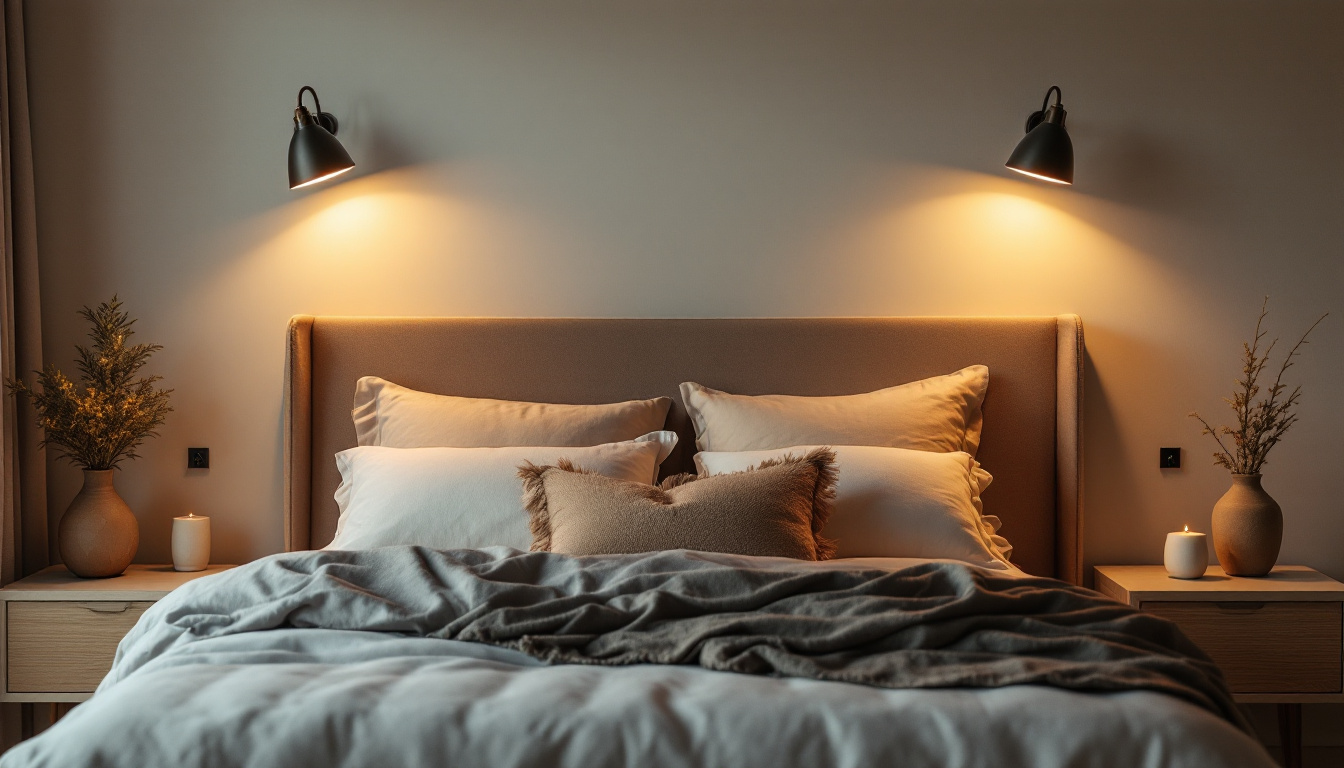
In the realm of interior lighting, the over bed light is a crucial element that combines functionality with aesthetics. For lighting professionals, understanding the nuances of over bed lighting is essential to meet client expectations and enhance the overall ambiance of a space. This article serves as a comprehensive checklist, guiding lighting contractors through the key considerations and best practices for implementing effective over bed lighting solutions.
The primary function of over bed lighting is to provide adequate illumination for various activities that take place in the bedroom, such as reading, relaxing, or even working. However, the role of this lighting extends beyond mere functionality; it also contributes significantly to the room’s atmosphere. The right lighting can transform a bedroom from a simple sleeping space into a sanctuary that reflects personal style and promotes well-being. It can evoke feelings of tranquility or energy, depending on how it is utilized, making it a vital component of interior design.
When designing over bed lighting, it is important to consider the specific needs of the user. For instance, a reading light should offer focused illumination without disturbing a partner’s sleep. On the other hand, ambient lighting can create a calming environment conducive to relaxation. Thus, understanding the purpose behind the lighting choice is the first step in the design process. Additionally, incorporating dimmable options can further enhance flexibility, allowing users to adjust the brightness according to the time of day or mood. This adaptability can be particularly beneficial for those who enjoy winding down with a book before sleep or need a brighter light for tasks like journaling or working on a laptop in bed.
There are several types of over bed lighting that professionals can choose from, each serving different functions. Common options include wall-mounted fixtures, pendant lights, and recessed lighting. Each type has its own set of advantages and considerations that must be weighed during the planning phase. For example, wall-mounted fixtures can be equipped with adjustable arms, allowing users to direct light precisely where it is needed, making them ideal for readers who may shift positions frequently.
Pendant lights, on the other hand, can serve as a stylish focal point while offering general illumination. They come in a variety of designs, from minimalist to ornate, which can complement the overall decor of the room. Recessed lighting provides a sleek, unobtrusive option that can be adjusted for brightness and direction, making it perfect for modern spaces where a clean aesthetic is desired. Furthermore, the choice of bulbs—whether LED, incandescent, or smart technology—can also influence energy efficiency and the quality of light, allowing homeowners to tailor their lighting solutions to their preferences and lifestyle.
Effective over bed lighting is often achieved through a layered approach. By combining ambient, task, and accent lighting, professionals can create a versatile and inviting space. Ambient lighting sets the overall mood, while task lighting provides focused illumination for specific activities. Accent lighting can highlight decorative elements, adding depth and interest to the room. This multi-dimensional approach not only enhances functionality but also allows for a more dynamic design that can adapt to various activities and times of day.
When layering lights, it is essential to consider the brightness and color temperature of each layer. Warmer tones tend to create a cozy atmosphere, while cooler tones can make a space feel more energetic. Balancing these elements will enhance the overall design and functionality of the lighting scheme. Additionally, integrating smart lighting solutions can further elevate the experience, allowing users to control brightness and color temperature through apps or voice commands, providing an effortless way to customize the ambiance of the bedroom according to their needs and preferences. This level of control not only adds convenience but also encourages a more mindful approach to how we use our spaces, promoting relaxation and well-being in our personal sanctuaries.
Designing effective over bed lighting requires careful consideration of several factors. These include the layout of the room, the height of the ceiling, and the preferences of the occupants. Each of these elements plays a critical role in determining the most suitable lighting solutions.
The layout of the bedroom significantly impacts the choice of over bed lighting. For instance, if the bed is positioned against a wall, wall-mounted fixtures may be ideal. Conversely, a bed placed in the center of the room might benefit from pendant lights or a chandelier, providing illumination from above.
Additionally, the functionality of the room should guide the design process. If the bedroom doubles as a workspace, brighter task lighting may be necessary. Understanding how the space will be used helps to tailor the lighting to the specific needs of the occupants.
ceiling height is another critical consideration when selecting over bed lighting fixtures. In rooms with low ceilings, recessed lighting or flush mount fixtures can provide adequate illumination without overwhelming the space. For higher ceilings, pendant lights or chandeliers can add a dramatic effect while still serving a functional purpose.
It’s also important to consider the scale of the fixtures in relation to the room size. Oversized fixtures can dominate a small space, while tiny fixtures may get lost in a grand room. Striking the right balance ensures that the lighting complements the overall design.
Understanding the preferences and lifestyle of the occupants is paramount in designing over bed lighting. Some individuals may prefer softer, dimmable lights for a calming environment, while others may require brighter, more focused lighting for reading or working.
Conducting a thorough consultation with the client can help uncover their specific needs and preferences. This information will guide the selection of fixtures, brightness levels, and control options, ensuring that the final design aligns with the client’s vision.
Beyond aesthetics and functionality, technical considerations are vital for successful over bed lighting installations. These include electrical requirements, fixture placement, and control systems. Each of these elements must be carefully planned to ensure safety and effectiveness.
Before selecting fixtures, it is crucial to evaluate the electrical requirements of the chosen lighting options. This includes understanding wattage, voltage, and the type of bulbs used. Ensuring that the electrical system can support the selected fixtures will prevent issues down the line.
Furthermore, consider the placement of outlets and switches. Adequate access to power sources will facilitate installation and enhance the usability of the lighting system. Incorporating dimmer switches can also provide flexibility, allowing users to adjust the brightness according to their needs.
Proper fixture placement is essential for achieving the desired lighting effect. For wall-mounted fixtures, the ideal height is typically around 60 to 66 inches from the floor, allowing for comfortable access when reading in bed. Pendant lights should be hung at a height that provides adequate clearance while still illuminating the desired area.
In addition to height, the distance between fixtures should be carefully considered. Overlapping light pools can create unwanted shadows, while too much space can leave areas inadequately lit. A balanced approach will ensure even illumination throughout the space.
Incorporating control systems into over bed lighting can enhance user experience significantly. Smart lighting solutions allow for remote control via mobile devices or voice commands, providing convenience and flexibility. Dimming capabilities can also be integrated, allowing users to adjust the lighting according to their mood or activity.
When selecting control systems, ensure compatibility with the chosen fixtures and the overall electrical setup. Educating clients on how to use these systems effectively can also enhance their satisfaction with the final installation.
While functionality is paramount, the aesthetic appeal of over bed lighting should not be overlooked. The right fixtures can serve as statement pieces, enhancing the overall design of the bedroom. When selecting fixtures, consider the style of the room and the preferences of the occupants.
The style of the lighting fixtures should complement the overall design theme of the bedroom. For a modern aesthetic, sleek, minimalist fixtures may be appropriate. Conversely, a more traditional room may benefit from ornate chandeliers or vintage-inspired sconces.
Color and finish are also important considerations. Metallic finishes can add a touch of elegance, while matte or textured finishes can create a more casual feel. Selecting fixtures that harmonize with other design elements, such as furniture and decor, will create a cohesive look.
The color temperature of the bulbs used in over bed lighting can significantly affect the room’s ambiance. Warmer tones (around 2700K to 3000K) create a cozy, inviting atmosphere, ideal for relaxation. Cooler tones (above 4000K) can energize a space, making them suitable for work areas.
When designing over bed lighting, consider incorporating a mix of color temperatures to offer versatility. This approach allows users to adjust the mood of the room according to their activities, whether it’s winding down for the night or gearing up for a productive day.
Over bed lighting is an essential aspect of bedroom design that requires careful consideration and planning. By understanding the purpose of the lighting, key design considerations, and technical requirements, lighting professionals can create solutions that meet the needs of their clients while enhancing the overall aesthetic of the space.
Ultimately, successful over bed lighting combines functionality with style, creating a space that is both inviting and practical. By following this essential checklist, lighting contractors can ensure that their designs not only illuminate but also elevate the bedroom experience for their clients.
Ready to elevate your lighting projects with the perfect over bed solutions? At LumenWholesale, we offer an exceptional range of spec-grade lighting products that blend quality with unbeatable wholesale value. Say goodbye to inflated markups and hello to a curated selection that meets the highest industry standards. With free shipping on bulk orders, you can stock up on premium lighting without the hidden fees. Make your next project shine with the best value in lighting—visit Wholesale Lighting at the Best Value and discover the LumenWholesale difference today.

Discover how gallery lighting not only highlights art but also plays a crucial role in ensuring safety.

Discover essential tips for selecting the right tanning bed lights and learn how to steer clear of common pitfalls in lighting projects.

Discover the intricacies of motion detector lights from a contractor’s perspective.

Discover everything lighting contractors need to know about 200W lumens in this comprehensive guide.